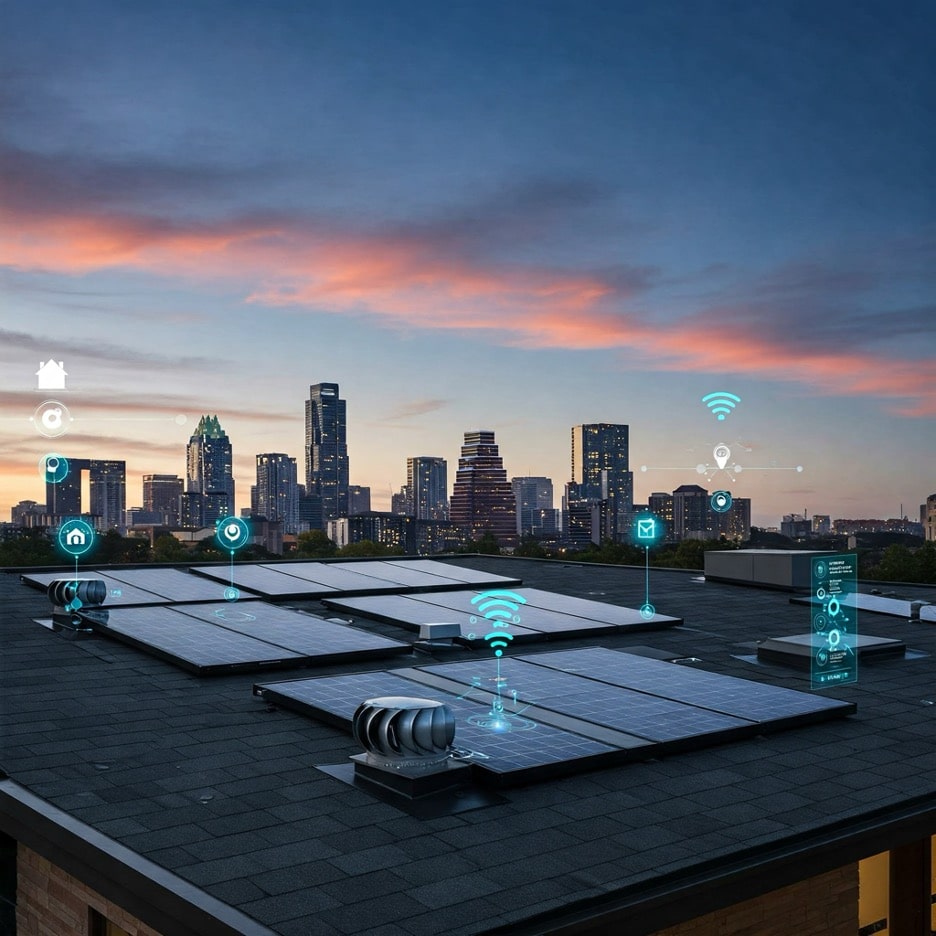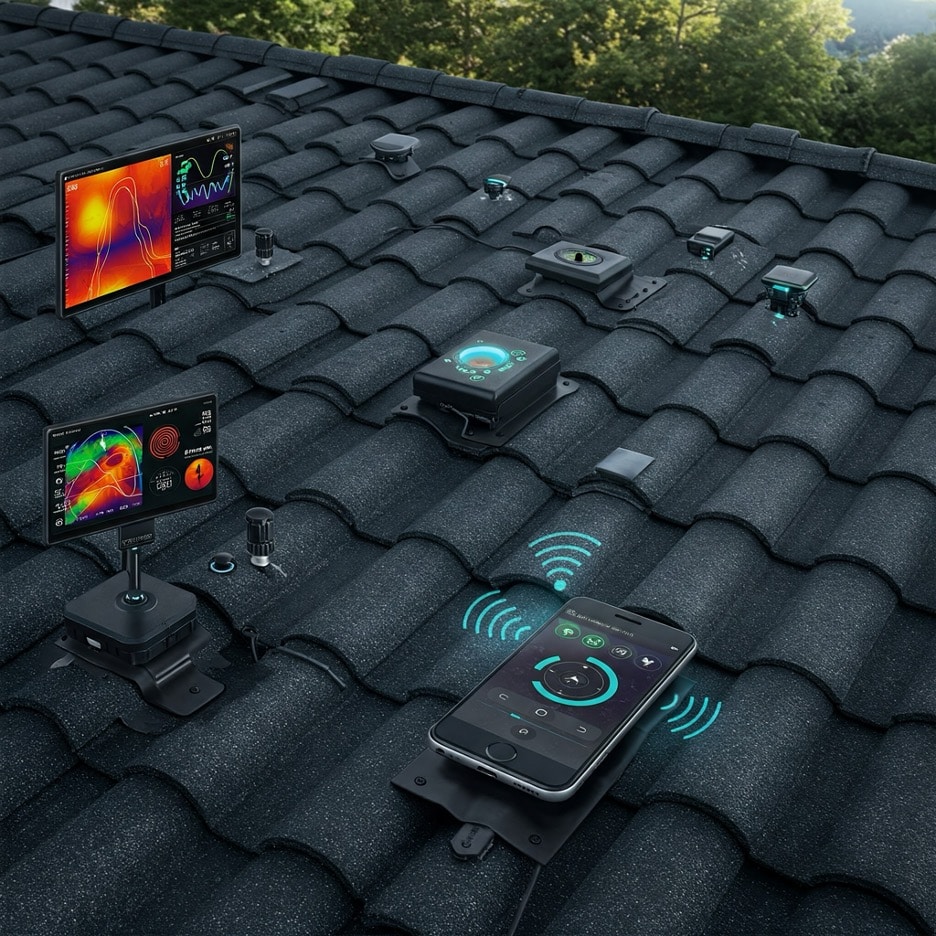Smart Roofing Technology: Modern Solutions for Austin Homes
The evolution of roofing technology has brought unprecedented capabilities to Austin homes. Smart roofing systems now offer homeowners real-time monitoring, automated responses to weather conditions, and integration with home automation systems. This comprehensive guide explores the latest innovations in roofing technology and how they’re transforming home protection and efficiency.

Key Insights: Smart Roofing AdvantagesKey Takeaways:
- What Defines Smart Roofing Technology?
- How Do Smart Sensors Protect Your Roof?
- What Integration Options Exist?
- How Does Automated Maintenance Work?
- What Energy Management Features Are Available?
- How Do Weather Response Systems Function?
- What Security Features Are Included?
- How Do You Choose Smart Roofing Systems?
- What Installation Requirements Exist?
- What Future Technologies Are Coming?
What Defines Smart Roofing Technology?
Smart roofing represents a revolutionary advancement in home protection, combining traditional roofing materials with cutting-edge technology. These systems transform a passive roof into an active component of your home’s management system:
Core Components: Modern smart roofing systems typically include:
- Integrated moisture detection
- Temperature monitoring networks
- Automated ventilation control
- Solar energy management
- Real-time structural monitoring

How Do Smart Sensors Protect Your Roof?
The integration of intelligent sensors throughout your roofing system creates a comprehensive monitoring network that provides unprecedented protection. These advanced systems operate continuously, offering real-time insights into your roof’s condition:
Moisture Detection: Advanced moisture sensors monitor multiple roof layers, detecting water infiltration before visible damage occurs. The system tracks:
- Surface moisture levels
- Internal moisture migration
- Condensation formation
- Drainage efficiency
- Historical moisture patterns
Temperature Monitoring: Smart temperature sensors create detailed thermal maps of your roof, helping identify:
Heat accumulation zones that might affect energy efficiency Cold spots indicating insulation failures Temperature differential patterns suggesting structural issues Ventilation effectiveness in different weather conditions Seasonal temperature variation impacts
Structural Monitoring: Continuous structural assessment through:
- Load distribution analysis
- Movement detection
- Stress point identification
- Weather impact evaluation
- Long-term wear patterns
These integrated monitoring systems communicate directly with your home automation hub, providing instant alerts and automatic response activation when issues are detected.
What Integration Options Exist?
Modern smart roofing systems offer extensive integration capabilities with existing home automation platforms:
Home Automation Connectivity:
- Direct integration with major smart home systems
- Custom alert configurations
- Mobile app monitoring
- Voice command compatibility
- Automated response programming
The system can trigger specific actions based on detected conditions:
- Adjusting HVAC settings for optimal efficiency
- Activating ventilation systems
- Engaging emergency protocols
- Notifying maintenance services
- Documenting system responses
How Does Automated Maintenance Work?
Smart roofing systems revolutionize maintenance through automated protocols that respond to real-time conditions. This proactive approach significantly reduces the risk of serious roofing issues:
Preventive Maintenance: The system continuously evaluates roofing conditions and automatically:
- Adjusts ventilation based on moisture levels
- Monitors and reports material degradation
- Schedules professional inspections
- Tracks maintenance history
- Predicts potential issues
Real-Time Response: When issues are detected, smart systems can:
Initiate emergency protocols during severe weather Adjust internal climate controls to prevent condensation Activate deicing systems in freezing conditions Deploy protective measures during high winds Alert homeowners and contractors to developing problems
What Energy Management Features Are Available?
Smart roofing technology significantly enhances energy efficiency through sophisticated management systems:
Solar Integration: Modern smart roofs incorporate advanced solar technologies:
- Intelligent panel positioning
- Real-time efficiency monitoring
- Production optimization
- Consumption tracking
- Storage system integration
Climate Control: Smart roofing systems actively contribute to climate management:
The system analyzes external conditions and adjusts internal responses accordingly. Advanced algorithms predict weather patterns and prepare appropriate responses. Automated ventilation systems optimize airflow based on current conditions. Integration with HVAC systems maximizes efficiency and reduces energy costs. Real-time monitoring ensures optimal performance in all weather conditions.
How Do Weather Response Systems Function?
Weather response capabilities represent one of the most sophisticated aspects of smart roofing technology:
Predictive Response: Smart systems utilize weather data to:
- Prepare for incoming storms
- Adjust drainage patterns
- Modify ventilation settings
- Engage protective measures
- Monitor structural stress
Security Features and Monitoring:
Advanced security features in smart roofing systems provide comprehensive protection beyond traditional roofing concerns:
Access Monitoring: Smart roofs incorporate sophisticated security measures:
- Motion detection on roof surfaces
- Unauthorized access alerts
- Maintenance tracking systems
- Video surveillance integration
- Emergency response protocols
Data Security: Protection of system information includes:
Encrypted communication channels between components and monitoring stations. Secure cloud storage of historical data and performance metrics. Protected access to control systems and settings. Regular security updates and protocol improvements. Backup systems for critical monitoring functions.
How Do You Choose Smart Roofing Systems?
Selecting the right smart roofing system requires careful consideration of several factors:
Compatibility Assessment: Before installation, evaluate:
- Existing home automation systems
- Structural requirements
- Climate-specific needs
- Budget considerations
- Future expansion capabilities
A comprehensive system should offer:
Scalability for future technology integration. Flexible monitoring and control options. Regular software and firmware updates. Professional support and maintenance services. Clear warranty and service agreements.
What Installation Requirements Exist?
Installing smart roofing technology demands specialized expertise:
Infrastructure Needs: Successful installation requires:
- Robust power supply systems
- Reliable internet connectivity
- Proper sensor placement
- Integration with existing systems
- Backup power solutions
Professional installation teams must understand:
- Advanced electrical systems
- Network infrastructure
- Roofing material compatibility
- Data collection protocols
- Emergency backup procedures
What Future Technologies Are Coming?
The horizon of smart roofing technology continues to expand with emerging innovations:
Upcoming Developments:
- Self-healing roofing materials
- Advanced AI integration
- Improved energy harvesting
- Enhanced automation capabilities
- Expanded integration options
Research and development focuses on:
Creating more resilient and adaptive systems. Improving energy efficiency and generation capabilities. Enhancing automated response mechanisms. Developing more sophisticated monitoring tools. Expanding integration with smart city infrastructure.
Smart roofing technology represents a significant advancement in home protection and efficiency. These systems transform traditional roofing structures into intelligent, responsive components of modern home automation. By combining advanced monitoring capabilities with automated responses and sophisticated energy management, smart roofs offer unprecedented control and protection for Austin homeowners.
The investment in smart roofing technology provides multiple benefits:
- Enhanced protection through early problem detection
- Improved energy efficiency and cost savings
- Automated maintenance and response systems
- Integration with existing home automation
- Future-ready expandability
Implementation Considerations:
When considering smart roofing technology, homeowners should:
Evaluate their specific needs and goals for automation. Consider long-term maintenance and upgrade requirements. Plan for future technology integration. Work with qualified installation professionals. Maintain regular system updates and monitoring.
The Future of Roofing:
As technology continues to evolve, smart roofing systems will become increasingly sophisticated and integral to home management. These advancements promise:
- Greater energy efficiency
- Enhanced protection
- Improved automation
- Expanded capabilities
- Increased home value
For Austin homeowners looking to protect their investment while embracing modern technology, smart roofing systems offer a compelling solution that combines innovation with practical benefits. By understanding and implementing these advanced systems, homeowners can ensure their properties are well-protected and future-ready.






